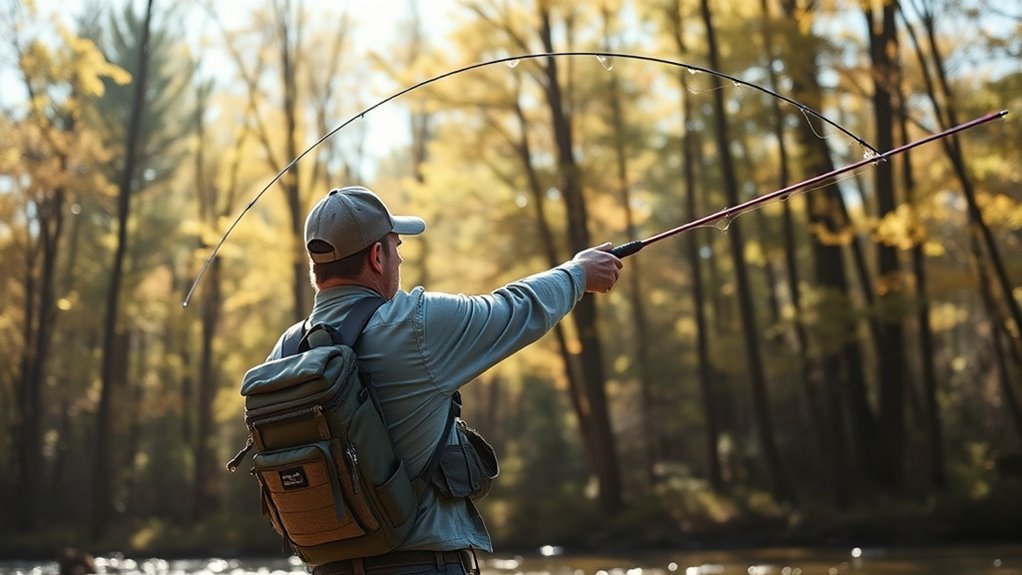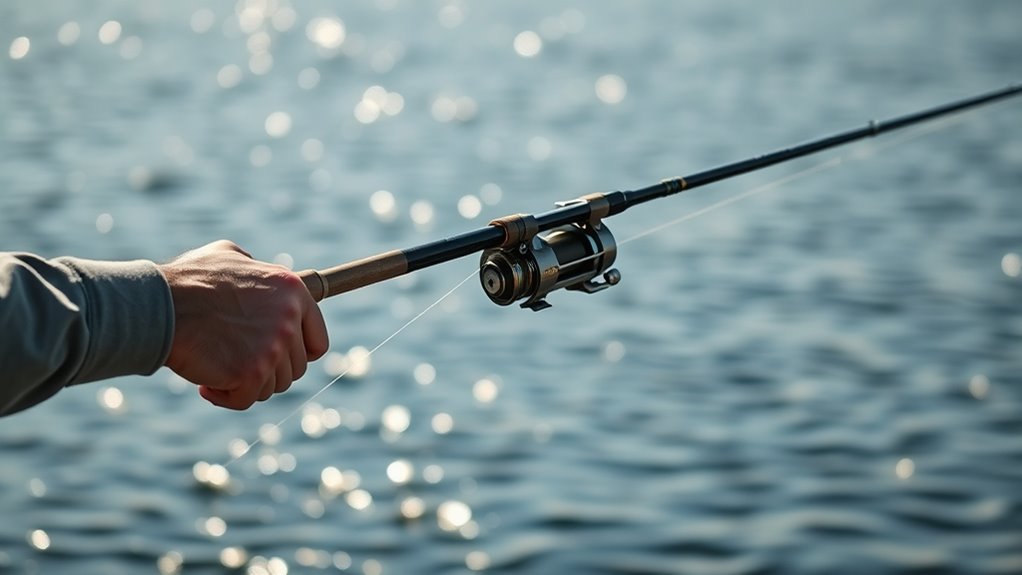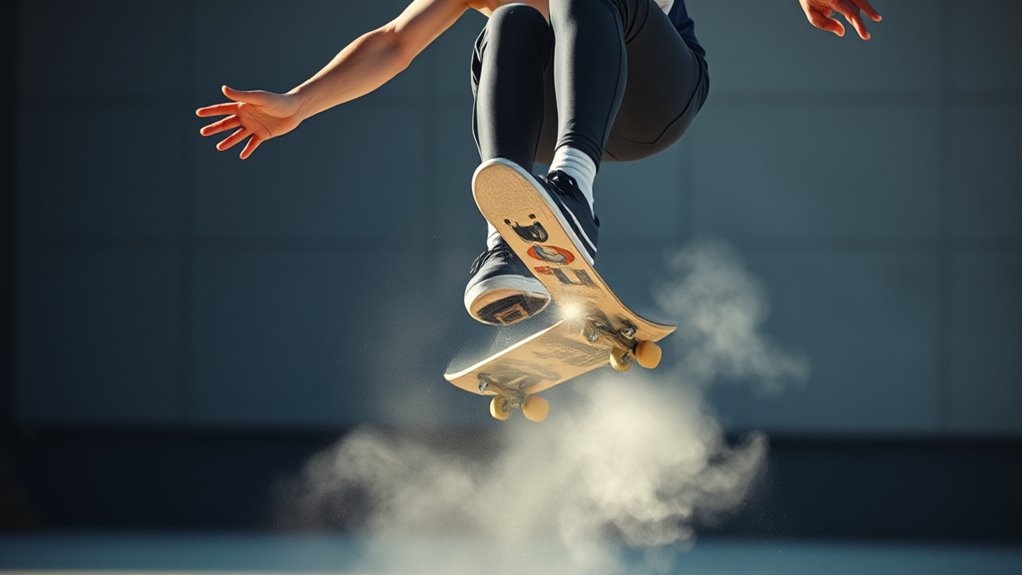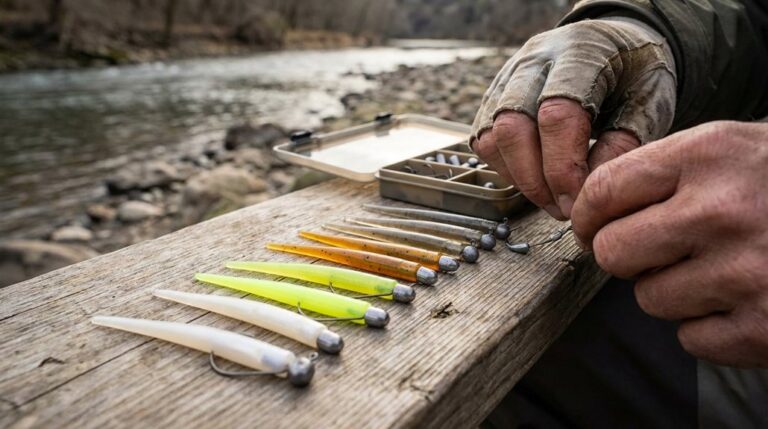You’ll add reliable distance and pinpoint accuracy by matching rod power, reel spool, line and lure so the blank loads properly and the spool turns smoothly. Practice short, targeted drills plus heavy-weight distance casts to build timing and thumb control; accept some backlashes while you learn. Use overhead for range, sidearm for low-trajectory accuracy, and switch to pitching or flipping for tight shots. Learn wind, free-spool, and skipping adjustments and you’ll get both reach and precision—keep going to pick up practical drills and setups.
Important Takeaways
- Load the rod fully with a properly matched rod power and lure weight so the blank flexes and stores energy for longer casts.
- Use an overhead cast for maximum distance and switch to sidearm when accuracy around cover is needed.
- Control spool rotation with firm thumb pressure during free-spool to prevent overruns and optimize line release.
- Reduce wind effects by keeping a low, tight arc, casting with wind at your back, and using heavier lures or line.
- Practice short-range precision (pitching/flipping) after locating fish to convert distance into accurate, target placement.
Practice Drills to Build Consistent Casting Mechanics
Want to tighten your casting so distance and accuracy become automatic? You’ll focus on repetition and consistency so a repeatable casting motion and steady arc become second nature. Set up yard practice with a heavy weight or lure to simulate load and build comfort with casting distance, and accept occasional backlashes as part of learning. Use short-range practice drills like controlled target casts to sharpen precision for flipping and pitching under tight constraints. Stay patient, adjust grip, timing, and line control to reduce snarls. Don’t forget to work bait presentation alongside lure practice to improve bite potential in shallow water. Keep sessions focused and measured, tracking progress so improvements in casting and accuracy compound. Also remember to practice on calm waters while wearing a properly fitted PFD to reinforce safety as you build skills.
Gear Setup: Matching Rod, Reel, Line, and Lure
How do you get your rig to load and release efficiently for both distance and pinpoint casts? Match rod power to lure weight so the blank flexes—use about a 3–5 kilo rod for a 3/8 oz jig head with a 5-inch paddle tail. Balance reel spool and line with the rod; mismatches kill load transfer. Check that line and lure weights sit inside the rod’s recommended range. Align eyelets with guides to reduce friction and improve line flow. Add a ~300 mm fluorocarbot leader to keep a clean path and prevent tangles.
- Visualize the rod tip loading like a spring.
- Picture the reel spool spinning smoothly.
- See the line unspooling without wobble.
- Imagine the lure slicing the air.
- Feel the blank release energy instantly. A machined aluminum housing on a quality reel gives you added durability and corrosion protection for consistent performance in salt and freshwater.
Overhead Versus Sidearm: When to Use Each Cast

When should you throw overhead versus sidearm? You’ll use overhead casting when you want maximum casting distance and to cover wide water; it trades some placement control for reach. Switch to sidearm casting when you need accuracy and reach around cover, tight structure, or to skip lures under docks. Use overhead when wind favors long, straight casts and distant fish; accept reduced control. Use sidearm for lower trajectory, less line visibility, and safer hookups near obstacles. A practical routine: start wide with overhead to locate fish, then switch to sidearm for targeted work. Always wear a properly fitting PFD and be mindful of safety when choosing where and how you cast.
| Situation | Cast | Benefit |
|---|---|---|
| Open water | Overhead | Max casting distance |
| Near structure | Sidearm | Precision placement |
| Windy long casts | Overhead | Better reach |
Pitching and Flipping for Short-Range Precision
After working the water with overhead and sidearm casts to find fish, you’ll tighten up to pitching and flipping for pinpoint shots into heavy cover. You focus on a compact rod sweep, minimal wrist motion, and keeping the line tight so your lure lands exactly where you want. A quick snap of the wrist and a low, level trajectory reduce line slap and keep the bait stealthy. Practice short distances from different angles so small rod-angle changes translate into spot-on placement. Pitching and flipping give you the accuracy and control to fish tight to weeds, docks, or laydowns without spooking bass.
- A bait slipping silently behind a tangle of weed stems
- A trailer hook dropping beside a dock post
- Line whispering over lily pads
- Bait threading through a stump hole
- Lure settling inches from submerged brush
- For heavy-cover situations consider using a medium-heavy power rod to help control and extract fish from dense structure.
Techniques to Maximize Casting Distance

Want to get your bait out beyond the weeds and into the strike zone? To maximize casting distance, set your baitcast reel to free spool during the cast by removing braking or magnetic controls so the spool spins freely. Use firm thumb control on the spool to prevent overruns and keep long-throw accuracy. Match lure weight and line type to reach deeper zones—heavier lures and appropriate line help cranks get down. Consider using both hands when boat position or target layout favors added leverage. Start with a smooth, loaded rod and accelerate through the initial cast to build rod load; that rapid, controlled acceleration transfers energy efficiently for longer, more consistent casts. Practice timing between thumb control and rod load for best results. Bluefin tuna are among the largest species encountered off San Diego, often reaching remarkable sizes that reward offshore anglers with epic fights and memorable trips bluefin tuna.
Casting Strategies for Windy Conditions
How do you keep control and distance when the wind kicks up? You adapt your Casting to the Wind: favor heavier lures or line to hold momentum, lower your trajectory to cut drift, and trust a smooth rhythm. Position your body so gusts hit your side slightly; that steadies line control and improves Accuracy. Aim a touch lower on crosswinds and cast with the Wind at your back when you can to gain Distance. Practice builds confidence—use simple drills to read shifts and react without overcompensating.
- Visualize a low, tight arc slicing through gusts toward the target.
- Feel the rod load heavier lures fighting the Wind.
- Picture your feet planted against a sideways blow.
- Imagine aiming below a distant bobber.
- See a wind sock reveal shifting angles.
Adding heavier, well-matched gear like a medium-heavy rod and stronger line can help maintain control in gusts and improve casts with matched tackle.
Tips to Improve Skipping Accuracy

When the wind is under control and you’ve practiced steady casts, shift focus to skips—short, precise shots that get lures under docks and low cover. Use a free-spool technique by dialing down braking or magnetic controls on your baitcast reel, then feather line with your thumb to blend casting distance and skipping control. Keep a light but firm wrist action and a steady arc, holding the rod tip angle at about 45 degrees so the lure cleaves and bounces cleanly.
Position the lure just behind the target, load quickly, then snap and stop to force a tight skip path. Start with medium-heavy lures and heavier line to reduce backlash while you practice skips on hard, flat surfaces or calm water to refine line control. Kayak anglers also benefit from practicing skips in mangrove tunnels where quiet, precise presentation is essential.
Final Thoughts
You’ve got the tools and drills to boost both accuracy and reach — now it’s on you to practice. Focus on consistent mechanics, match your gear to conditions, and pick the right cast for the shot. Work on pitching, flipping, and skipping for tight spots, and tweak technique for windy days. Drill these habits until they’re automatic, and you’ll cast farther and truer, landing more fish and enjoying every confident, controlled cast.




